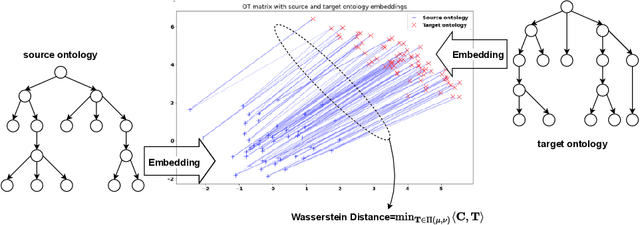Alex Kalinowski
Enhancing Semantic Interoperability Across Materials Science With HIVE4MAT
Nov 01, 2024



Abstract:HIVE4MAT is a linked data interactive application for navigating ontologies of value to materials science. HIVE enables automatic indexing of textual resources with standardized terminology. This article presents the motivation underlying HIVE4MAT, explains the system architecture, reports on two evaluations, and discusses future plans.
Is the Lecture Engaging for Learning? Lecture Voice Sentiment Analysis for Knowledge Graph-Supported Intelligent Lecturing Assistant (ILA) System
Aug 20, 2024Abstract:This paper introduces an intelligent lecturing assistant (ILA) system that utilizes a knowledge graph to represent course content and optimal pedagogical strategies. The system is designed to support instructors in enhancing student learning through real-time analysis of voice, content, and teaching methods. As an initial investigation, we present a case study on lecture voice sentiment analysis, in which we developed a training set comprising over 3,000 one-minute lecture voice clips. Each clip was manually labeled as either engaging or non-engaging. Utilizing this dataset, we constructed and evaluated several classification models based on a variety of features extracted from the voice clips. The results demonstrate promising performance, achieving an F1-score of 90% for boring lectures on an independent set of over 800 test voice clips. This case study lays the groundwork for the development of a more sophisticated model that will integrate content analysis and pedagogical practices. Our ultimate goal is to aid instructors in teaching more engagingly and effectively by leveraging modern artificial intelligence techniques.
Knowledge Graph Question Answering for Materials Science (KGQA4MAT): Developing Natural Language Interface for Metal-Organic Frameworks Knowledge Graph (MOF-KG)
Sep 20, 2023Abstract:We present a comprehensive benchmark dataset for Knowledge Graph Question Answering in Materials Science (KGQA4MAT), with a focus on metal-organic frameworks (MOFs). A knowledge graph for metal-organic frameworks (MOF-KG) has been constructed by integrating structured databases and knowledge extracted from the literature. To enhance MOF-KG accessibility for domain experts, we aim to develop a natural language interface for querying the knowledge graph. We have developed a benchmark comprised of 161 complex questions involving comparison, aggregation, and complicated graph structures. Each question is rephrased in three additional variations, resulting in 644 questions and 161 KG queries. To evaluate the benchmark, we have developed a systematic approach for utilizing ChatGPT to translate natural language questions into formal KG queries. We also apply the approach to the well-known QALD-9 dataset, demonstrating ChatGPT's potential in addressing KGQA issues for different platforms and query languages. The benchmark and the proposed approach aim to stimulate further research and development of user-friendly and efficient interfaces for querying domain-specific materials science knowledge graphs, thereby accelerating the discovery of novel materials.
Exploring Wasserstein Distance across Concept Embeddings for Ontology Matching
Jul 22, 2022



Abstract:Measuring the distance between ontological elements is a fundamental component for any matching solutions. String-based distance metrics relying on discrete symbol operations are notorious for shallow syntactic matching. In this study, we explore Wasserstein distance metric across ontology concept embeddings. Wasserstein distance metric targets continuous space that can incorporate linguistic, structural, and logical information. In our exploratory study, we use a pre-trained word embeddings system, fasttext, to embed ontology element labels. We examine the effectiveness of Wasserstein distance for measuring similarity between (blocks of) ontolgoies, discovering matchings between individual elements, and refining matchings incorporating contextual information. Our experiments with the OAEI conference track and MSE benchmarks achieve competitive results compared to the leading systems such as AML and LogMap. Results indicate a promising trajectory for the application of optimal transport and Wasserstein distance to improve embedding-based unsupervised ontology matchings.
Building Open Knowledge Graph for Metal-Organic Frameworks (MOF-KG): Challenges and Case Studies
Jul 10, 2022



Abstract:Metal-Organic Frameworks (MOFs) are a class of modular, porous crystalline materials that have great potential to revolutionize applications such as gas storage, molecular separations, chemical sensing, catalysis, and drug delivery. The Cambridge Structural Database (CSD) reports 10,636 synthesized MOF crystals which in addition contains ca. 114,373 MOF-like structures. The sheer number of synthesized (plus potentially synthesizable) MOF structures requires researchers pursue computational techniques to screen and isolate MOF candidates. In this demo paper, we describe our effort on leveraging knowledge graph methods to facilitate MOF prediction, discovery, and synthesis. We present challenges and case studies about (1) construction of a MOF knowledge graph (MOF-KG) from structured and unstructured sources and (2) leveraging the MOF-KG for discovery of new or missing knowledge.
 Add to Chrome
Add to Chrome Add to Firefox
Add to Firefox Add to Edge
Add to Edge